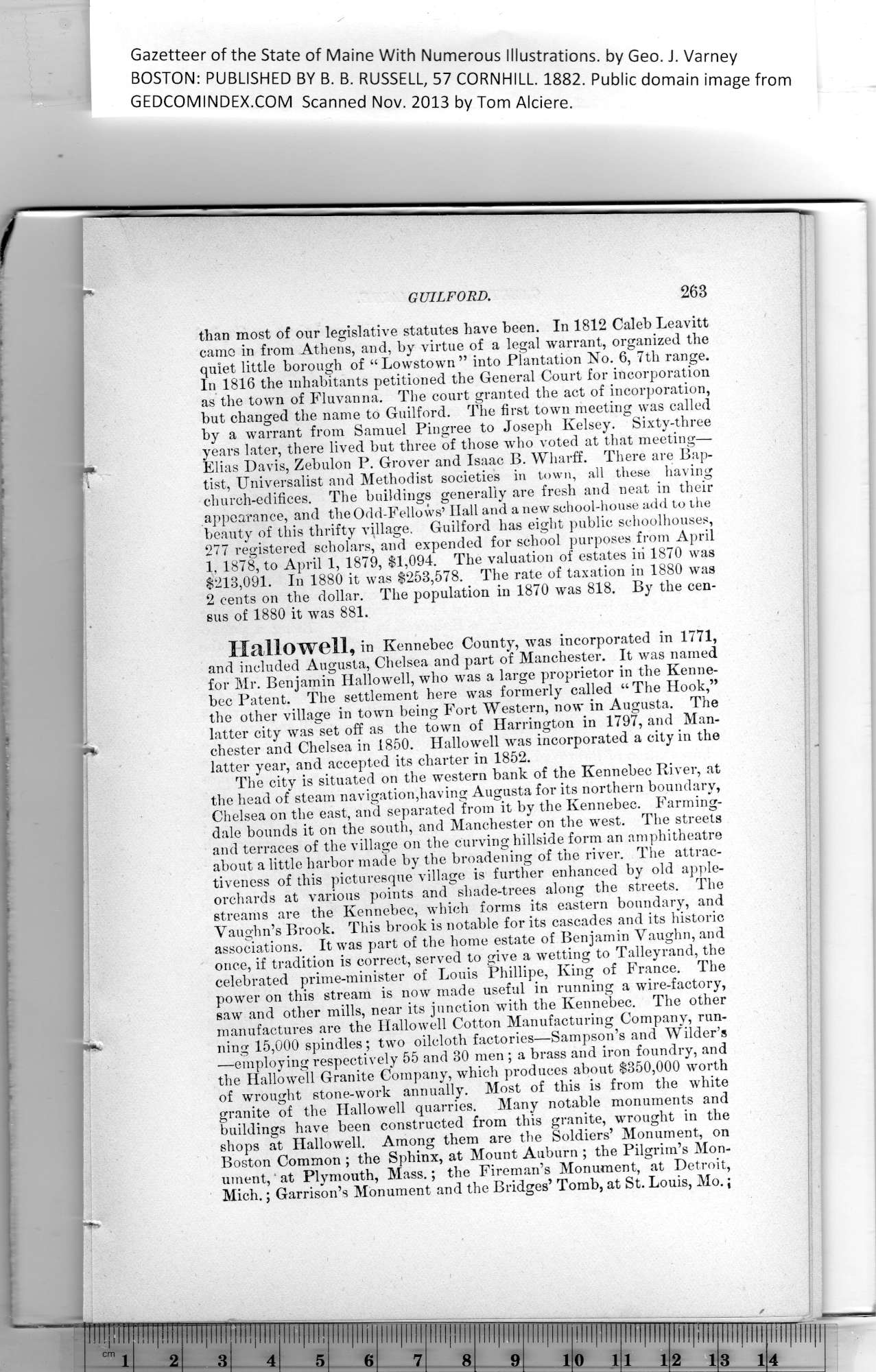|
Gazetteer of the State of Maine With Numerous Illustrations, by Geo. J. Varney
BOSTON: PUBLISHED BY B. B. RUSSELL, 57 CORNHILL. 1882. Public domain image from
GUILFORD. 263
than most of our legislative statutes have been. In 1812 Caleb Leavitt
came in from Athens, and, by virtue of a legal warrant, organized the
quiet little borough of “Lowstown” into Plantation No. 6, 7th range.
In 1816 the inhabitants petitioned the General Court for incorporation
as the town of Fluvanna. The court granted the act of incorporation,
but changed the name to Guilford. The first town meeting was called
by a warrant from Samuel Pingree to Joseph Kelsey. Sixty-three
years later, there lived but three of those who voted at that meeting—
Elias Davis, Zebulon P. Grover and Isaac B. Wharff. There are Bap-
tist, Universalist and Methodist societies in town, all these having
church-edifices. The buildings generally are fresh and neat in their
appearance, and the Odd-Fellows’ Hall and a new school-house add to the
beauty of this thrifty village, Guilford has eight public schoolhouses,
277 registered scholars, and expended for school purposes from April
1, 1878, to April 1, 1879, $1,094. The valuation of estates in 1870 was
$213,091. In 1880 it was $253,578. The rate of taxation in 1880 was
2 cents on the dollar. The population in 1870 was 818. By the cen-
sus of 1880 it was 881.
Hallowell, in Kennebec County, was incorporated in 1771,
and included Augusta, Chelsea and part of Manchester. It was named
for Mr. Benjamin Hallowell, who was a large proprietor in the Kenne-
bec Patent. The settlement here was formerly called “The Hook,”
the other village in town being Fort Western, now in Augusta. The
latter city was set off as the town of Harrington in 1797, and Man-
chester and Chelsea in 1850. Hallowell was incorporated a city in the
latter year, and accepted its charter in 1852.
The city is situated on the western bank of the Kennebec River, at
the head of steam navigation,having Augusta for its northern boundary,
Chelsea on the east, and separated from it by the Kennebec. Farming-
dale bounds it on the south, and Manchester on the west. The streets
and terraces of the village on the curving hillside form an amphitheatre
about a little harbor made by the broadening of the river. The attrac-
tiveness of this picturesque village is further enhanced by old apple-
orchards at various points and shade-trees along the streets. The
streams are the Kennebec, which forms its eastern boundary, and
Vaughn’s Brook. This brook is notable for its cascades and its historic
associations. It was part of the home estate of Benjamin Vaughn, and
once, if tradition is correct, served to give a wetting to Talleyrand, the
celebrated prim e-minister of Louis Phillipe, King of France. The
power on this stream is now made useful in running a wire-factory,
saw and other mills, near its junction with the Kennebec. The other
manufactures are the Hallowell Cotton Manufacturing Company, run-
ning 15,000 spindles; two oilcloth factories—Sampson’s and Wilder’s
—employing respectively 55 and 30 men ; a brass and iron foundry, and
the Hallowell Granite Company, which produces about $350,000 worth
of wrought stone-work annually. Most of this is from the white
granite of the Hallowell quarries. Many notable monuments and
buildings have been constructed from this granite, wrought in the
shops at Hallowell. Among them are the Soldiers’ Monument, on
Boston Common ; the Sphinx, at Mount Auburn ; the Pilgrim’s Mon-
ument, at Plymouth, Mass.; the Fireman’s Monument, at Detroit,
Mich.; Garrison’s Monument and the Bridges’ Tomb, at St. Louis, Mo.;
PREVIOUS PAGE ... NEXT PAGE
This page was written in HTML using a program written in Python 3.2
|
